

AnPyLar. PySide2 - Qt Wiki. Pyside for Qt 5.x The Pyside 2 project aims to provide a complete port of PySide to Qt 5.x.
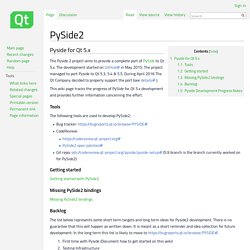
The development started on GitHub in May 2015. The project managed to port Pyside to Qt 5.3, 5.4 & 5.5. During April 2016 The Qt Company decided to properly support the port (see details ). This wiki page tracks the progress of PySide for Qt 5.x development and provides further information concerning the effort. Tools The following tools are used to develop PySide2: Getting started Getting started with PySide2 Missing PySide2 bindings. Ashiba — Continuum documentation. Ashiba is an app building framework, allowing you to define layout with HTML or Enaml and write logic in Python.

No Javascript needed! Download Ashiba Now! Licensing Ashiba is completely free to use and distribute Features Javascriptless Interactive Web Apps Installation Instructions The only hard dependencies are Python 2.7 and pyyaml.To run all of the examples, you should also have numpy and pandas installed.In order to make use of the build functionality, you need conda.For the best overall experience, use the Anaconda Python distributiongit clone git@github.com:ContinuumIO/ashiba.git cd ashiba python setup.py install Support For any questions about or problems with Ashiba , consult the Ashiba Mailing List for free community support. For extensive, long-term, or project-based support, Continuum’s Consulting and Training services are available. Crossplatform Framework for NUI. Frameworks. ActivUFRJ. Python in Neuroscience II. This Research Topic is also cross listed in Frontiers in Neuroinformatics Frontiers in Neuroinformatics hosted the research topic ...
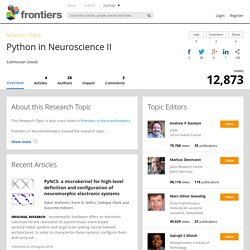
Frontiers in Neuroinformatics hosted the research topic “Python in Neuroscience” in 2008-2009, documenting the first wave of mature tools to propel Python into common use in the field. This widespread convergence on Python as the systems integration language of choice in Neuroscience has brought with it exciting new possibilities for cross-fertilization, collaboration, and interdisciplinary interaction. The Python ecosystem remains vibrant and inventive, and continues to produce cutting edge tools for Neuroscience research.
With this second research topic on “Python in Neuroscience” we seek to showcase the most exciting developments since 2009 that include, but are not limited to, the following themes: Software. RapydScript (pronounced 'RapidScript') is a pre-compiler for JavaScript, similar to CoffeeScript, but with cleaner, more readable syntax.
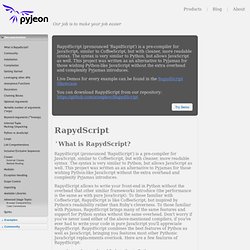
The syntax is very similar to Python, but allows JavaScript as well. This project was written as an alternative to Pyjamas for those wishing Python-like JavaScript without the extra overhead and complexity Pyjamas introduces. RapydScript allows to write your front-end in Python without the overhead that other similar frameworks introduce (the performance is the same as with pure JavaScript). To those familiar with CoffeeScript, RapydScript is like CoffeeScript, but inspired by Python's readability rather than Ruby's cleverness. To those familiar with Pyjamas, RapydScript brings many of the same features and support for Python syntax without the same overhead. Let's not waste any more time with the introductions, however. If you have questions, bug reports, or feature requests, feel free to post them on our mailing list: Python Data Analysis Library — pandas: Python Data Analysis Library. Lightweight Virtual Environments in Python 3.4. Pythonium/pythonium. Apache Libcloud: One Python library for all clouds.
Sometimes too much choice isn't a good thing.
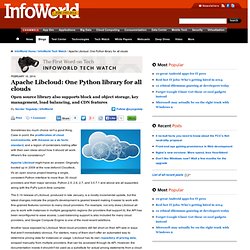
Case in point: the proliferation of cloud environments, with Amazon as a de facto standard, and a legion of contenders trailing after with their own ideas about how it should all work. Where's the consistency? Apache Libcloud might have an answer. Originally booted up in 2009 at the now-defunct Cloudkick, it's an open source project bearing a single, consistent Python interface to more than 30 cloud providers and their major services. Python 2.5, 2.6, 2.7, and 3.0.7.1 and above are all supported, along with the PyPy just-in-time compiler. The 0.14 release of Libcloud, produced in late January, is a mostly incremental update, but the latest changes indicate the project's development is geared toward making it easier to work with fine-grained features common to many cloud providers.
Another issue exposed by Libcloud: Most cloud providers still fall short on their API sets in ways that aren't immediately obvious. Python to the people — Pyzo - Python to the people. Code robots in Python. Fight other players. Climb to the top. Web2py Web Framework. Differences Between PyQt4 and PyQt5 — PyQt 5.0 Reference Guide. PyQt5 is not compatibile with PyQt4 (although experience shows that the effort in porting applications from PyQt4 to PyQt5 is not great).
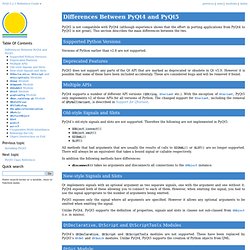
This section describes the main differences between the two. Pystachio - Python-to-JavaScript translator in JavaScript. Pystachio is an early-stage Python-to-JavaScript translator (written in JavaScript) aimed at providing Python scripting in any modern browser.
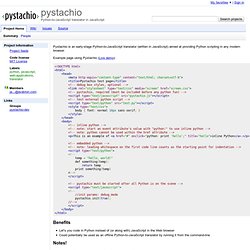
Example page using Pystachio (Live demo): Benefits Let's you code in Python instead of (or along with) JavaScript in the Web browser Could potentially be used as an offline Python-to-JavaScript translator by running it from the command-line Notes! Wallaby Application Framework by FreshX.